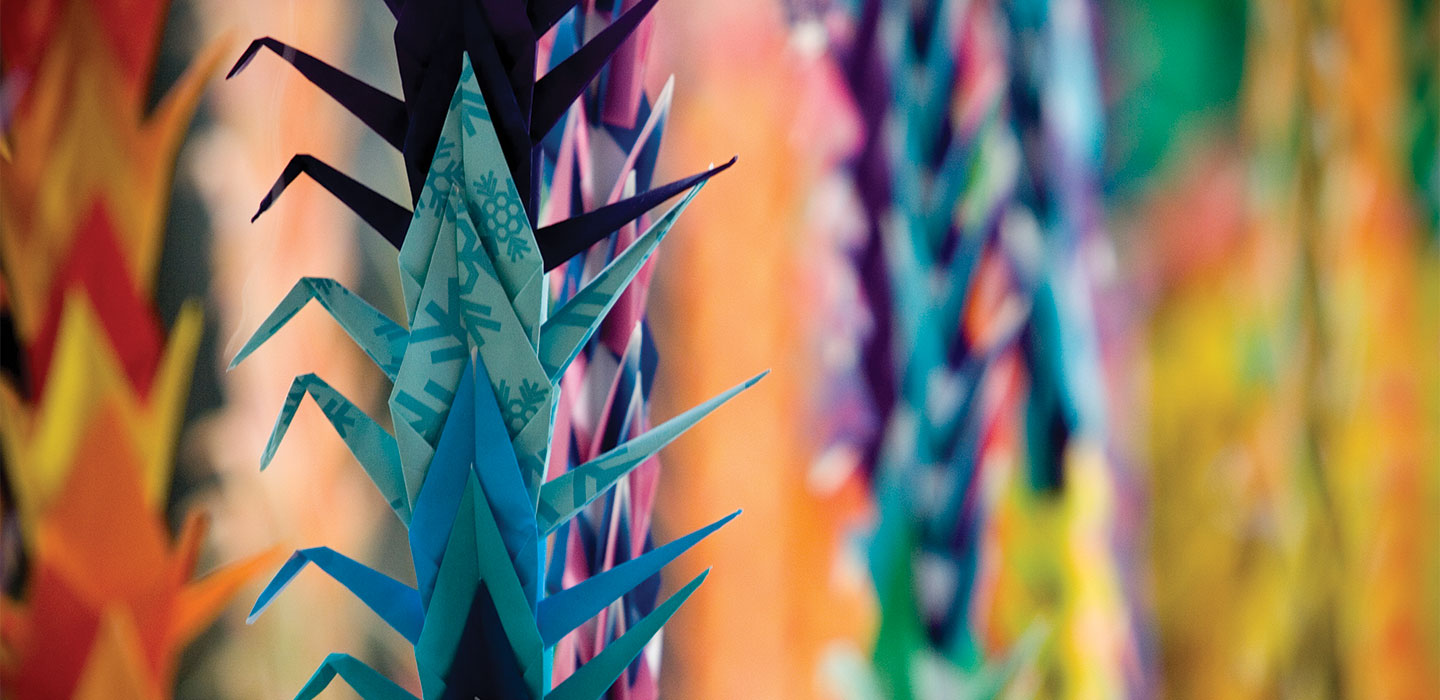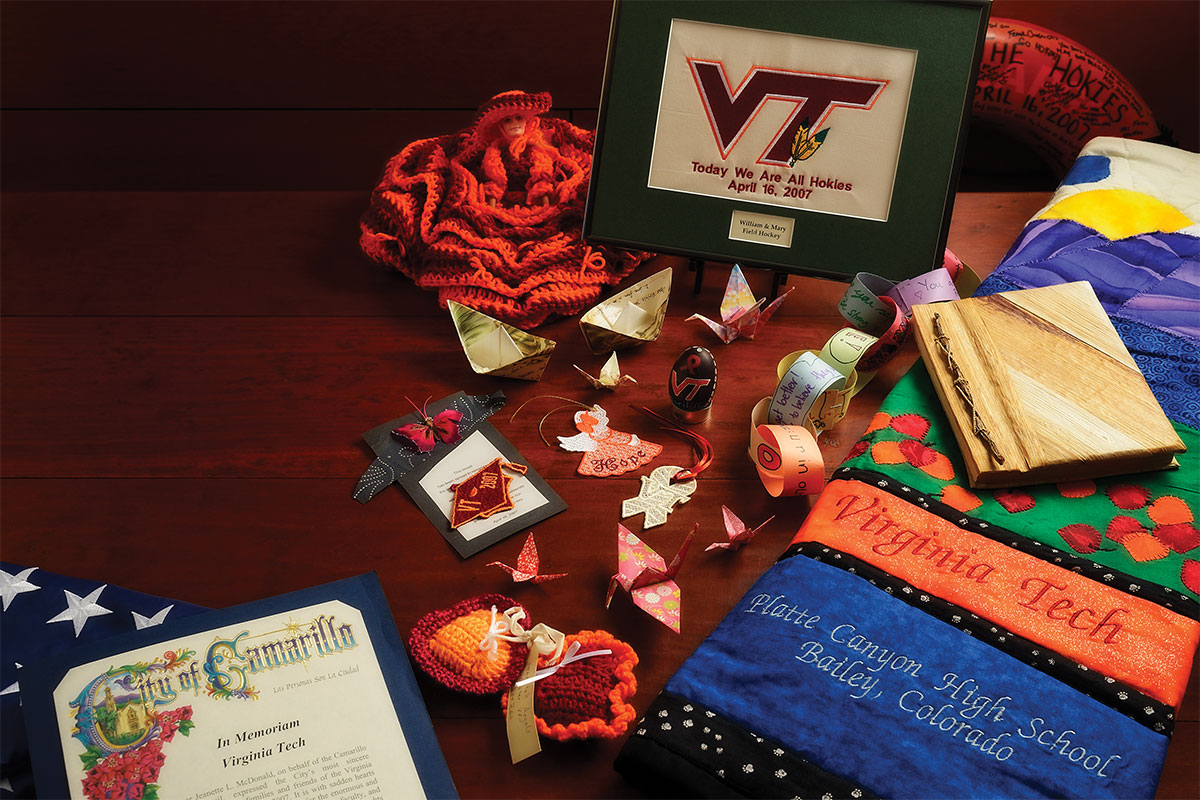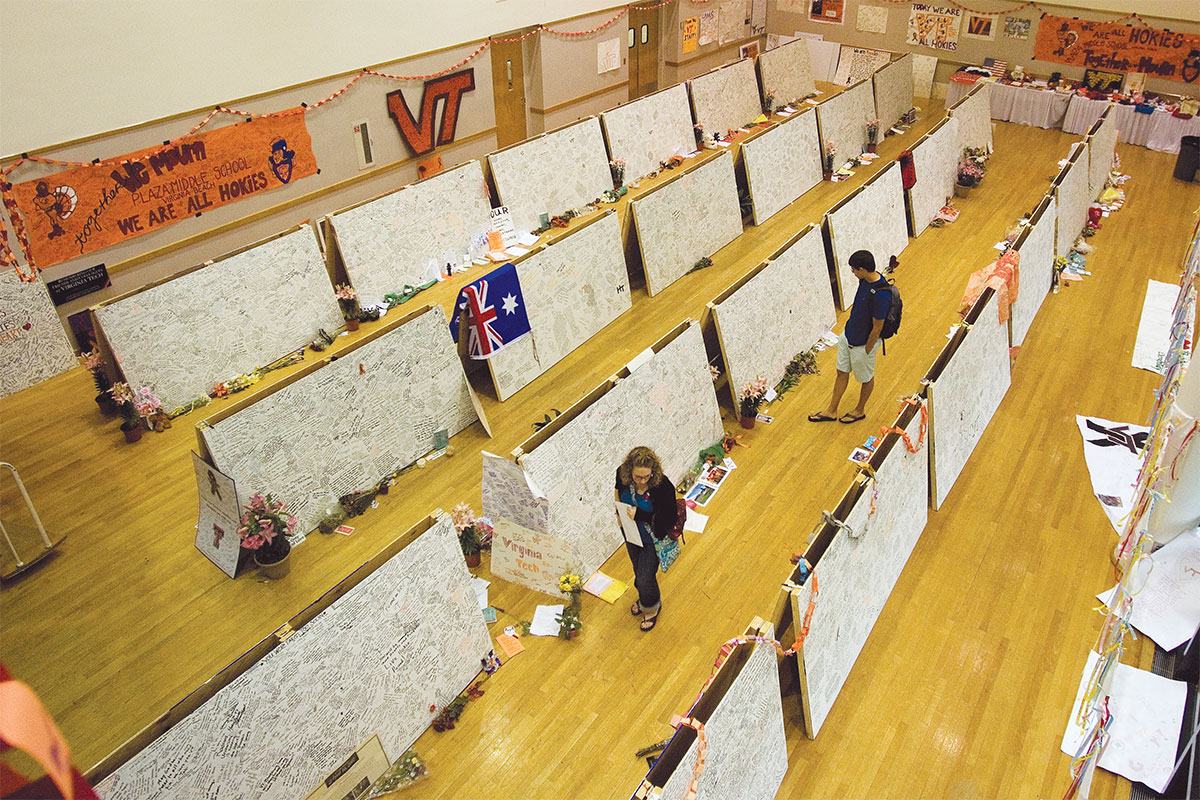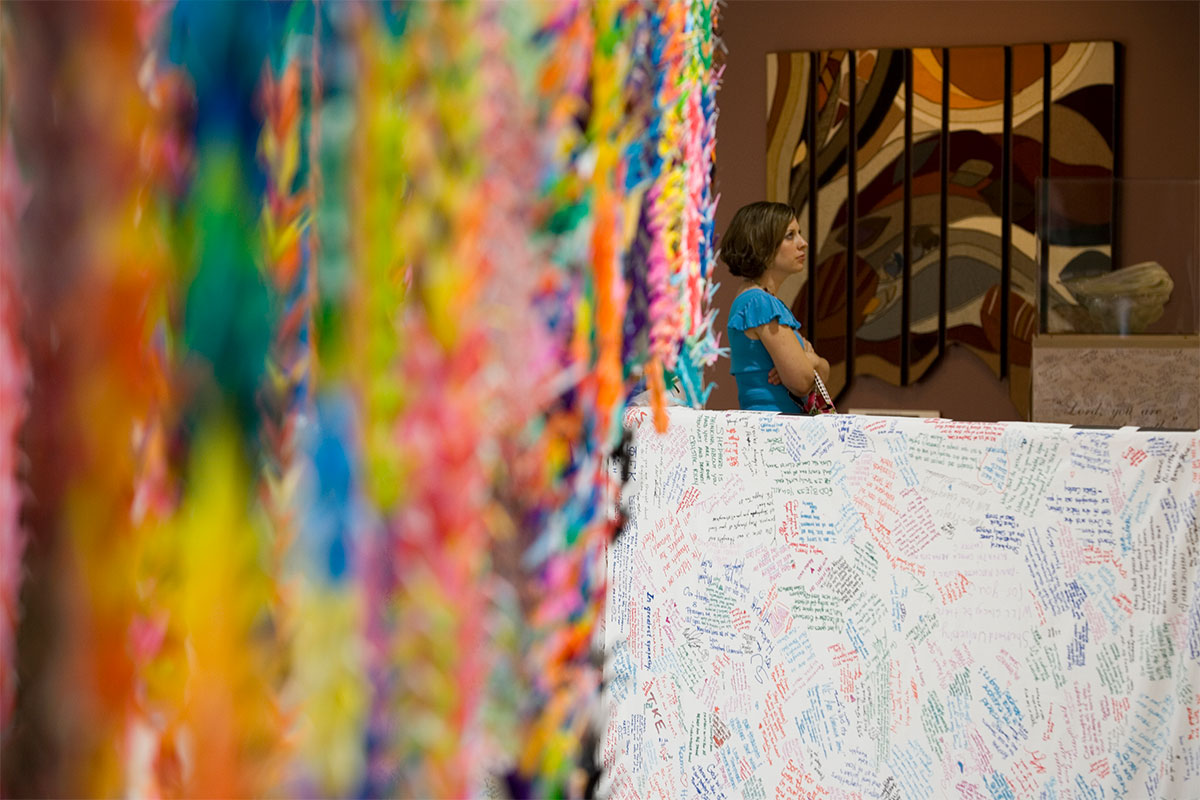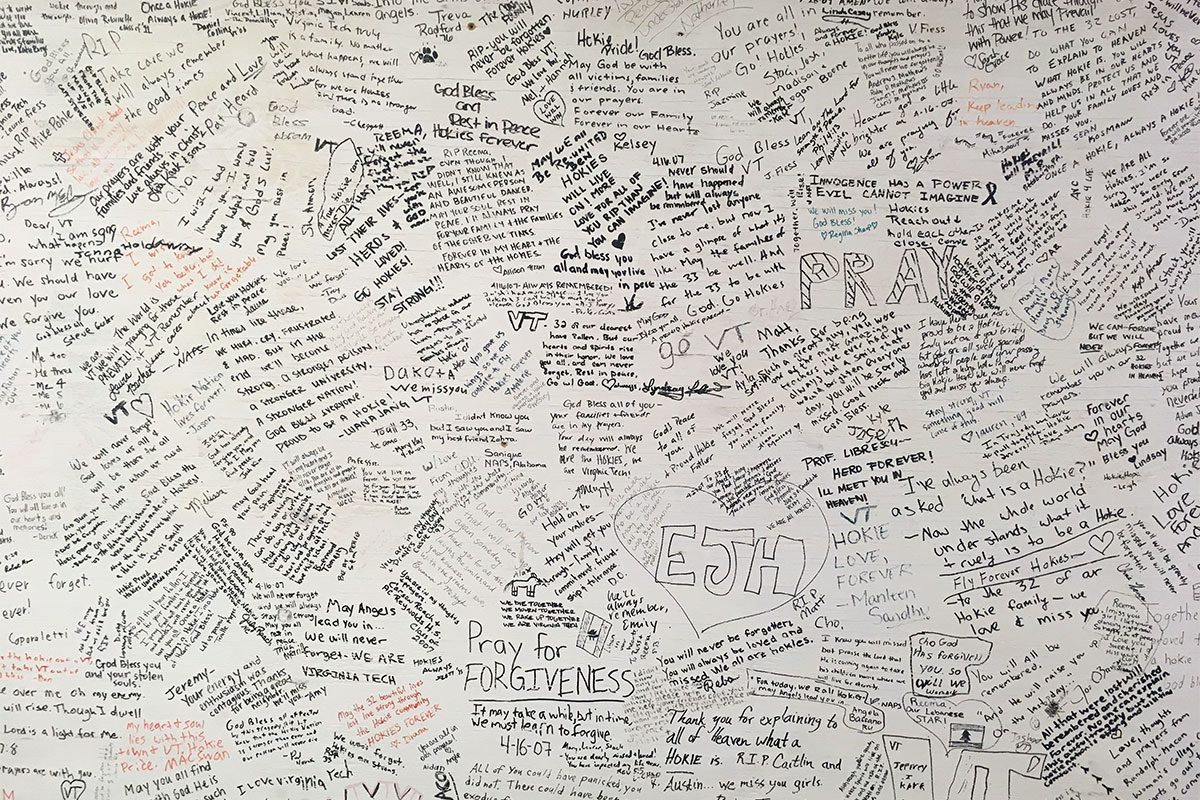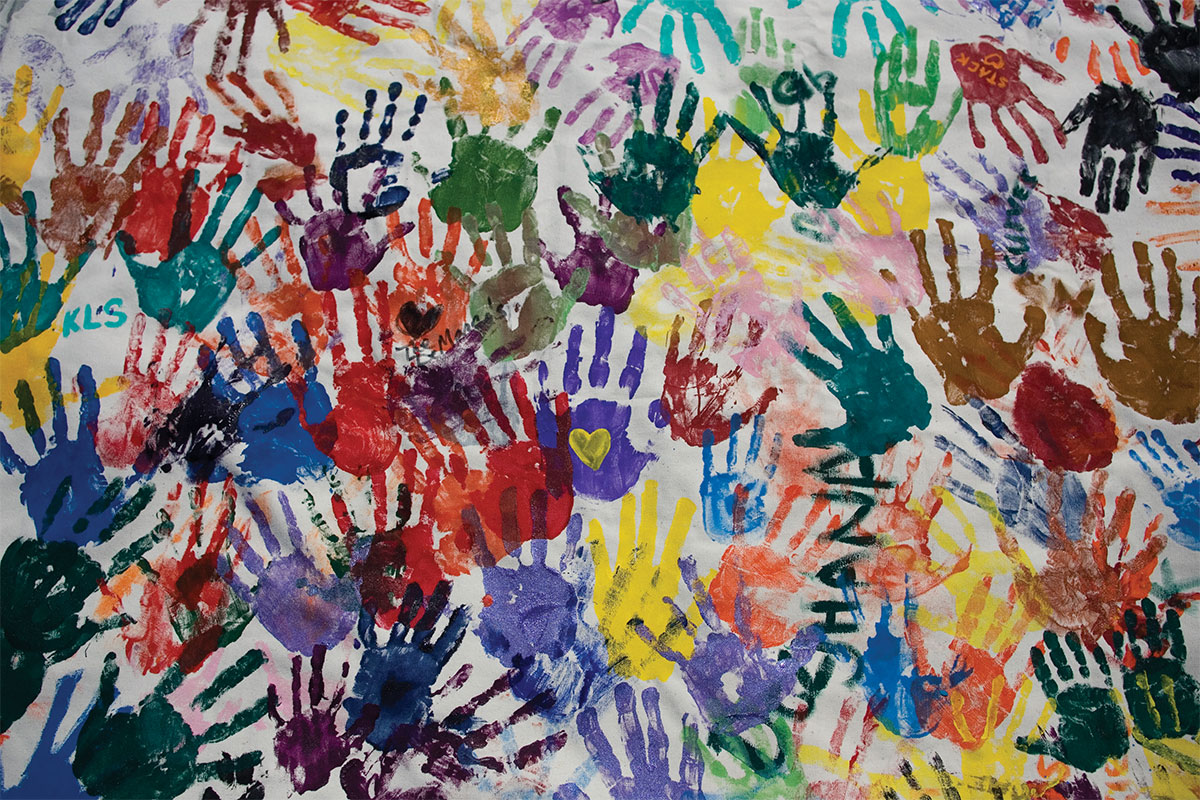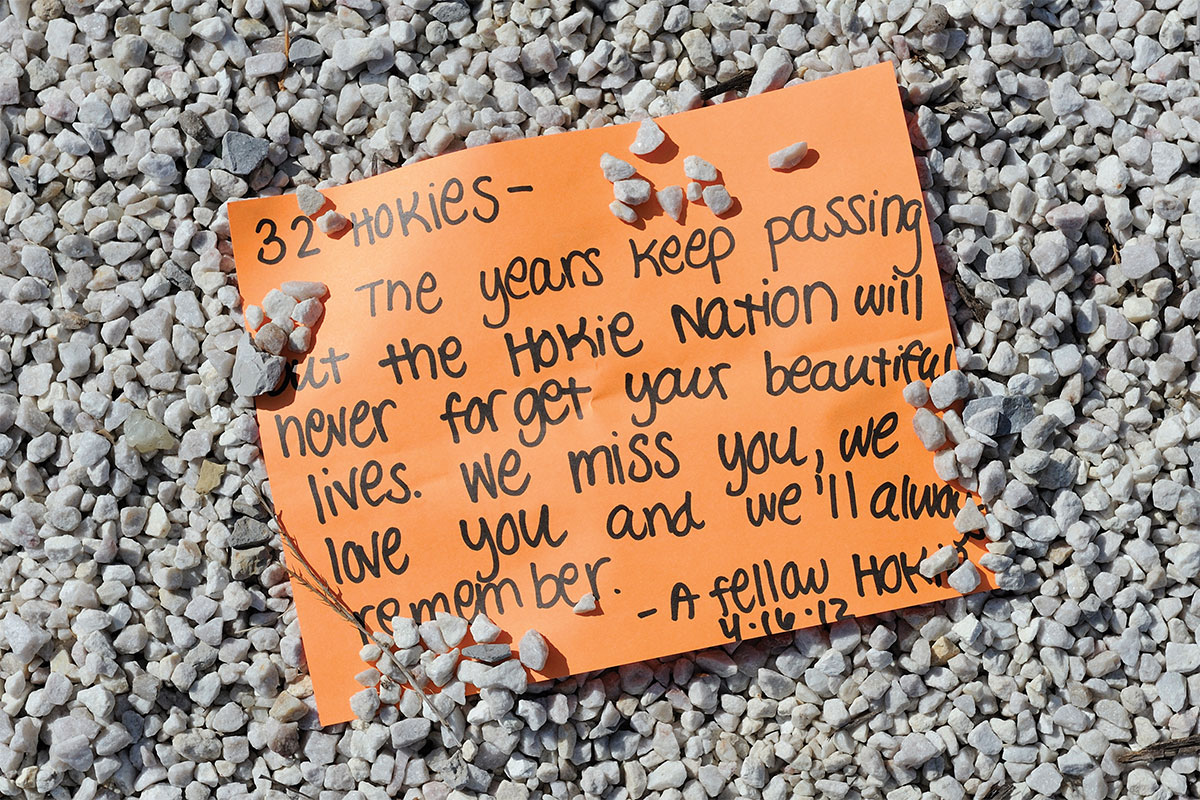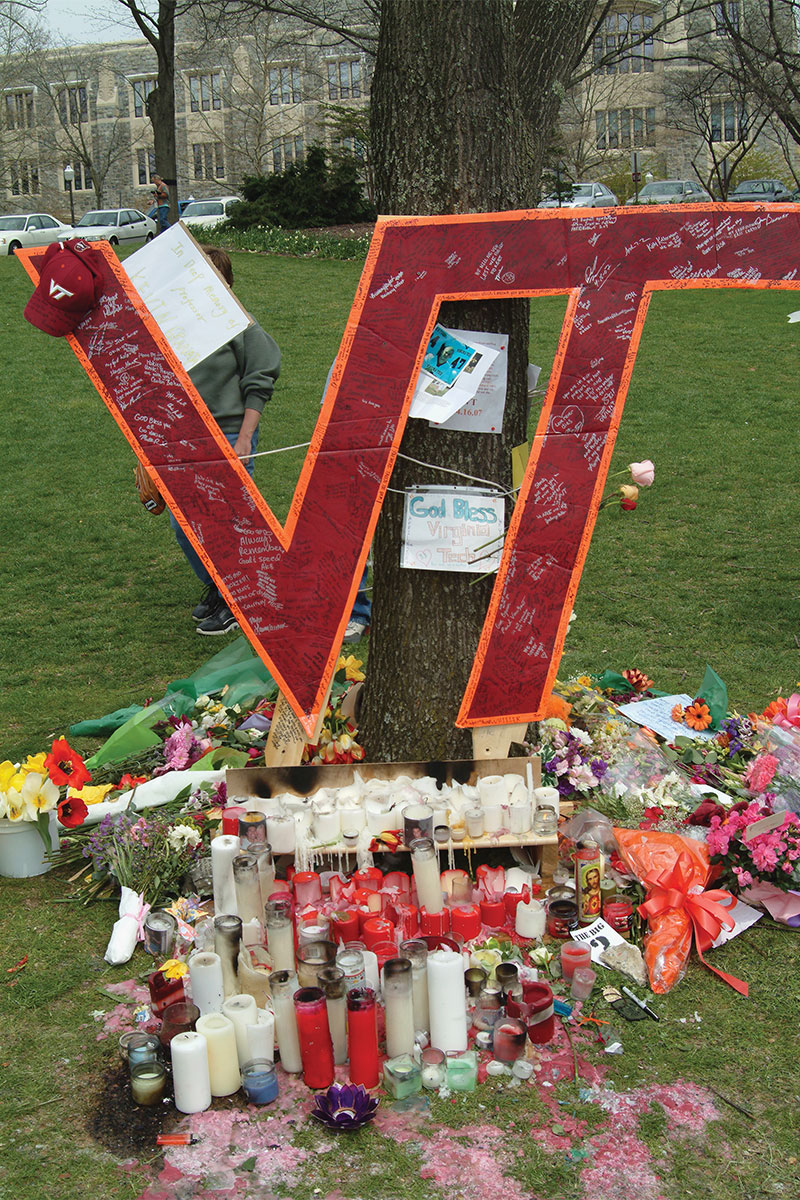by Mason Adams
After an outpouring of affection in the days following April 16, 2007, Virginia Tech archivists tackled the monumental task of recording and preserving the artifacts and the stories behind them.
scholar.lib.vt.edu/prevail
On April 16, 2007, after the lockdown had been lifted, as media shared the story with the world, and while investigators began to piece together the minutes, hours, and days leading up to the event, a community took the first steps to process its grief. As dusk settled over the Drillfield that evening, and Hokies quietly gathered together, people across the globe were already moving to pay tribute.
A student-driven volunteer group known as Hokies United placed pieces of Hokie Stone in a semi-circle to act as an ad-hoc memorial. Another group of friends placed a large "VT" prominently at the site. They mounted the giant letters to some lumber, tied it to a tree, and placed 32 candles at the base. The display became the backdrop for an impromptu candlelight vigil that drew thousands.
In the days that followed, more spontaneous memorials were left at the Drillfield. At Squires Student Center, packages full of condolence letters, art, and crafts accumulated, spilling out of the building.
Still, the tributes kept coming.
Tens of thousands of paper cranes. Cards and flowers. Thirty-two black pysanky eggs. Teddy bears. Handmade quilts. Paintings and poems and letters. Posters and signs and banners. Every item held space as a visible, tangible symbol of mourning.
It's not uncommon for institutions and communities to receive a flood of items in the wake of a publicized tragedy. But why?
Ashley Maynor, who was in Blacksburg managing the Lyric Theatre on April 16, 2007, felt compelled to explore this phenomenon. A former visiting assistant professor at Virginia Tech, Maynor produced a web documentary in 2015, "The Story of the Stuff," that examines the flood of items received by Virginia Tech and by the town of Newtown, Connecticut, following the violence at Sandy Hook Elementary School.
"There's no easy explanation for why people send this stuff," said Maynor, now assistant professor and digital humanities librarian at the University of Tennessee. "I did learn that grief is always individual, but it's also very universal. Everyone who sends stuff is grieving and expressing sympathy. All those expressions are unique. Sometimes they're beautiful, such as the hand-painted eggs that Virginia Tech received. Sometimes they're strange: Someone sent Cheerios and tube socks, which they thought would be comforting."
At Virginia Tech, the gifts continued to arrive as days turned into weeks and even months.
The day after the tragedy, Virginia Tech staff within Special Collections, an archival unit in the University Libraries' Carol M. Newman Library, began the process of arranging, describing, and housing a representative collection of the condolence items sent to campus.
The push was spurred in part by Ed Galvin — a longtime archivist and records manager at Syracuse University, who had collected and sorted materials sent after the Lockerbie bombing of Pan Am Flight 103 in 1988 — who on April 17, 2007, contacted University Archivist Tamara Kennelly to offer his expertise. In the days to come, other archivists from Bluffton University, which had lost a baseball team in a bus crash; Oklahoma State University, which had lost a basketball team in a plane crash; and Texas A&M University, which had lost 12 students in a bonfire accident, also reached out
Galvin's email became a call to action for Kennelly and the Special Collections staff. "I was like everyone else, walking out there just looking at the memorial," Kennelly said. "Suddenly it was like, 'Yes. Focus, that's what we need to do.'"
A working team from the University Libraries met with an advisory group from the Library of Congress to tackle the tidal wave of condolence items. Meanwhile, other groups, including representatives from the Dean of Students' office and a team of community volunteers, began to sort through the more than 90,000 items that had been sent to or left at Virginia Tech.
Cataloguing each item would take many months. As the details behind these contributions came together, they told a story of collective grief, shared compassion, and an intrinsic desire to channel feelings into actions.
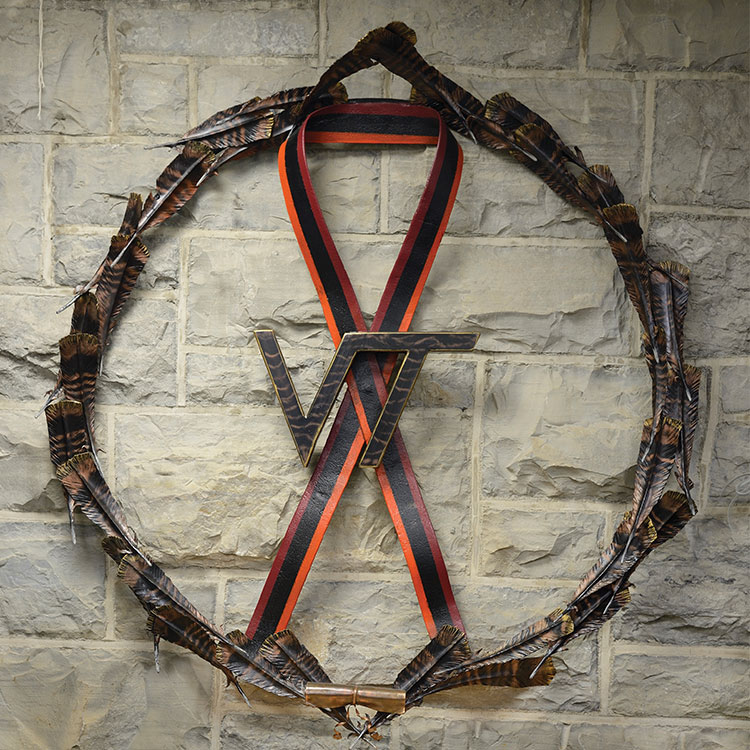
In 2008, Hunter Perkinson Jr. (industrial arts '80) created "Reclaimed Spirit" as a tribute to the victims.
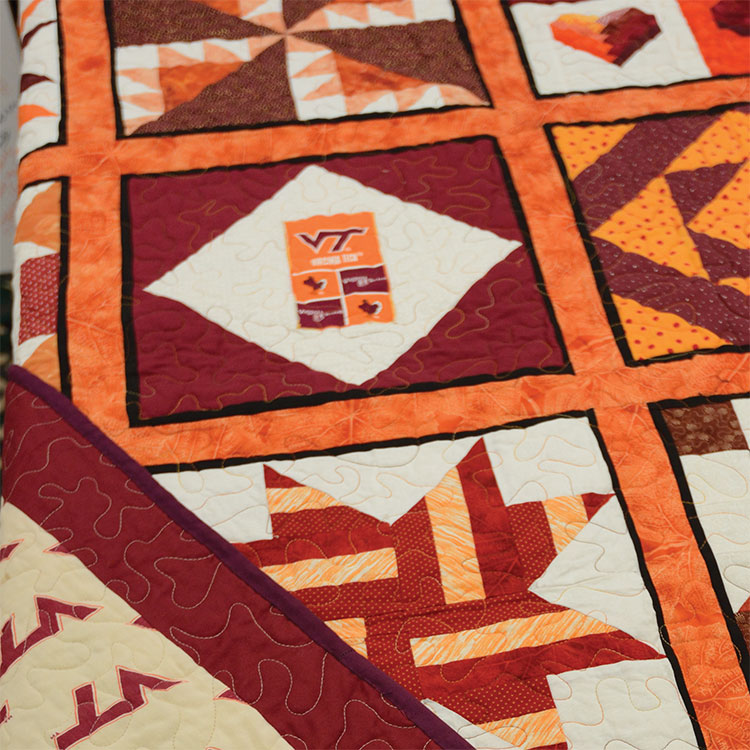
Quilts were among the many handcrafted items sent to Tech; the quilt pictured was created by Fairfax Quilters Unlimited.
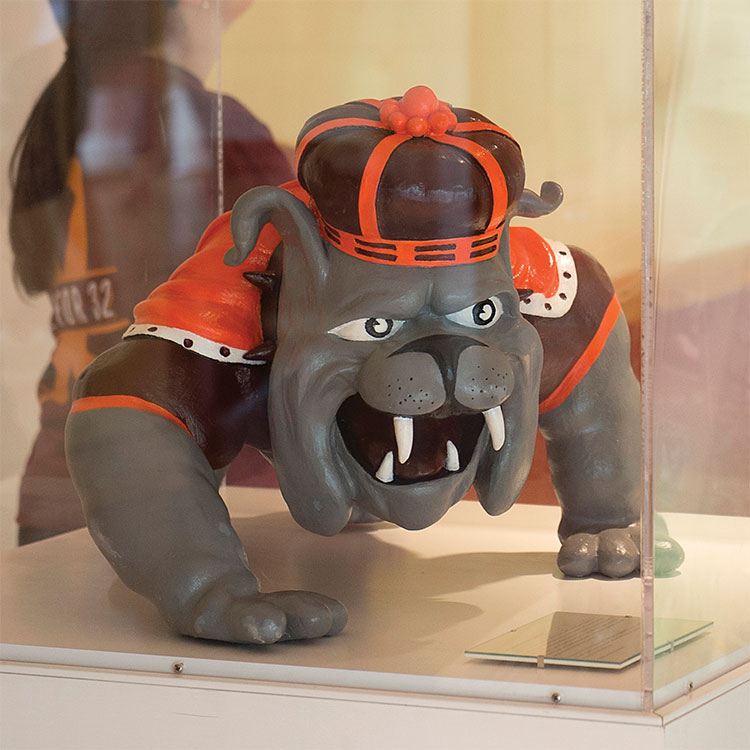
James Madison University donated a sculpture of their mascot, Duke Dog, wearing Hokie colors.
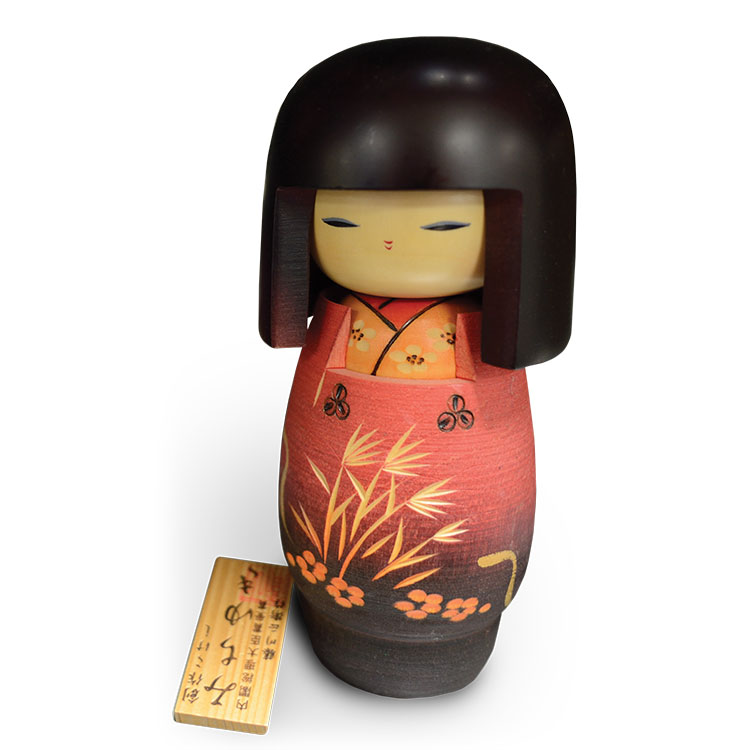
The Morale, Welfare, and Recreation Department of Commander Fleet Activities Yokosuka, a U.S. Navy base in Japan, sent a traditional doll to Tech.

U.S. Coast Guard members in San Juan, Puerto Rico, sent a signed life preserver.
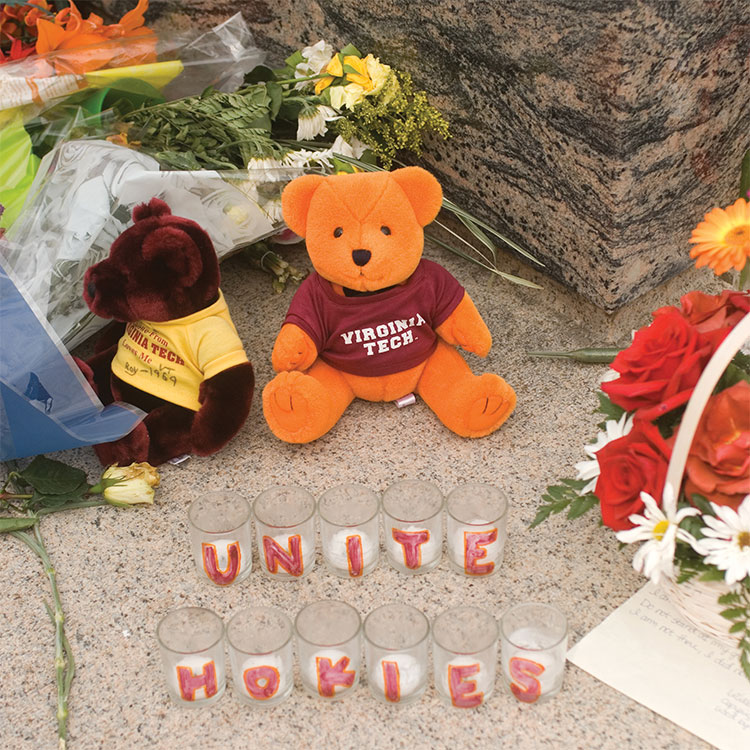
Teddy bears, flowers, and personal messages were left at various locations around campus in the days following April 16, 2007;
Brandon Stiltner (aerospace engineering '07, M.S. '11), one of the students responsible for the large "VT," now works at NASA in Huntsville, Alabama, but on the morning of April 16, 2007, he was a senior driving to Blacksburg from his parents' house in Grundy, Virginia. He became aware of what was happening long before he arrived in town, and he remembered spending that day watching coverage on TV with his roommates and neighbors.
"As the afternoon wore on, we were sitting around trying to figure out, is there anything we can do?" Stiltner said. "We sat around just talking. What can we do? What might help people or make a difference?"
A few days later, Carol Davis (environmental policy and planning '10) made her way to the Drillfield with her own tribute. She'd had to fly out of town the day of the shooting, and by the time she had returned, Blacksburg had been grieving for a few days.
"I never felt compelled to do something artistic, either before or since, but I was so overcome with grief and despair that I just decided to start," Davis said. "I don't remember having a very well-thought-out idea in my mind, but I knew there were these 32 people, and I didn't know really anything about any one of them. I did have the newspapers articles, where a little something had come out. I wanted to read these biographical sketches and come up with some symbolism in my head about each of these people."
She applied that framework to the labor-intensive, meditative process of creating 32 pysanky eggs, a Ukrainian tradition that incorporates wax and the repeated dipping of eggs into colored dye. At the end, a candle flame removes the wax to reveal the design, which often relies heavily on symbolism.
"I just had to do something with my mind and my hands in those weeks immediately after," said Davis. "It enabled me to focus my attention and do this process where I was able to think about each individual, instead of just the collective 32."
Nearly a year later, Hunter Perkinson Jr. (industrial arts '80), of Spotsylvania, Virginia, received an email about the upcoming anniversary and a related art show, which sparked inspiration.
"That whole thing sat in my craw for a year," Perkinson said. "I remember wanting to do something, but thinking what can you do? What is there to do? When I got that email, I knew instantly what to do. I had all these parts laying around in my rusty pallet, my junk pile. It was spontaneous: I thought, 'I'm going to make a wreath of 32 feathers.' It came into my mind's eye, the whole thing all at once. It was something I had to do to get rid of it, to do other things with my art."
Perkinson set to work blacksmithing what he called "Reclaimed Spirit" — 32 hand-forged gobbler feathers welded to a 4-foot ring. At the base of the wreath, he added a brass doorplate to form a rolled scroll representing degrees granted posthumously.
"Reclaimed Spirit" wasn't accepted into that year's art show, but Perkinson trekked across Southside Virginia to the Drillfield, where he left it next to the memorial in front of Burruss Hall.
"I felt like I had to get it off my chest," Perkinson said. "I had to do this for the victims."
Today, the big cardboard "VT," the pysanky eggs, and "Reclaimed Spirit" reside in Special Collections as part of the university's archive of materials. Kennelly and a team of university employees, community volunteers, and students worked for more than two years to collect, sort, label, photograph, and create a finding aid to make the collection more accessible.
The staff returns to those archives annually to select items for displays throughout campus in remembrance of that tragic day. Robin Boucher, arts program director for Student Engagement and Campus Life, has partnered with Kennelly since 2012 to select, curate, and display these materials.
"You have some people who've never had contact with the archives, so you want to be able to give them a glimpse of what it was like in a way that's poignant," Boucher said. "Then you have people who see it every year. You want to give them a glimpse of something they've not seen, but there's also a certain comfort in seeing familiar things."
The inherent beauty in the gifts, especially in the works of art, stems from the understanding that most of the pieces were created by people who are not trained artists or makers.
"It's a pure form of expression of spirit and a need to reach out to your fellow human being," Boucher said. "People reached into this part of themselves that often they never go to. Some people never ever go to their creative selves, but when they're grieving, they can find connection through creative processing. It helps them to extract something they can't put their finger on."
Boucher describes that process as "the essence of empathy."
"It's like scraping the bottom of the barrel," Boucher said. "What is it that's there you can put together to make a whole. It's taking pieces and making things whole again. That's what the creative process does: it takes fragments and disparate pieces and puts them together into a whole. Each item in the archives is someone trying to put back the pieces of something that's broken. So when you look at 90,000 items, you have this sense of loss, and you learn you have to live with that sense of loss, but you have also this deep connection with all of these people trying so hard with their hearts to make things right again."
That connection between grief and art, trauma and creativity, has been demonstrated through numerous studies, said David Trinkle, associate dean for community and culture and associate professor in psychiatry and behavioral medicine at the Virginia Tech Carilion School of Medicine.
"It's been long recognized that creativity and art, music, and writing all have healing aspects," Trinkle said. "After a crisis or tragedy, it's not at all uncommon for people to take to the artistic and creative ways to express their emotions, deal with their emotions, and handle their emotions in a way that ultimately is liberating and healing."
After making "The Story of the Stuff," Maynor said she came away impressed not just with the professionalism of the archivists at Tech, but also with the way in which they kept those archives open to the public through regular exhibitions. That's rare among the archival collections of tragedies, and it speaks to the sense of community among Hokies, not only in Blacksburg, but throughout wider world.
Maynor said she also drew wisdom from observing how other people processed and responded to tragedy.
"We all have to work through our grief in our own way," Maynor said. "The thing I'm trying to learn to do, and the lesson I've taken away from having made this film, is the best way we can work with that grief is to work in a proactive way toward positive change. What good is grief if we can't [channel it to] make the world a better place?"
A ringing remembrance
The Virginia Tech class ring tradition began during the 1911-12 academic year. Each year since, student representatives have designed a ring to reflect the distinctive characteristics of their class. The tragedy altered the design of class rings for every class since.
When the tragedy occurred, rings for the Class of 2007 and 2008 had already been made, and 2009's ring molds were being tooled. The ring maker offered to change the 2009 ring.
The committee did choose to change the design, but in a way that did not compromise the integrity of the original plan.

The Class of 2010 included a depiction of the memorial. Eight stars shine in the sky for the classmates they lost.
On the Class of 2011 ring, 32 tiny stones line up at the bottom curve of the ring on the university side. The ring also features a rising sun. The class understood from the beginning that they were the "phoenix class."
The Class of 2015 changed the usual chain of class year numbers around the bezel to a chain of 32 Hokie tracks, a feature that has remained on rings since. As the 10th class since 2007, the Class of 2017 depicted the anniversary with 10 of the stones of the April 16 Memorial.
– Laura Wedin (M.F.A. theatre arts '84), the Alumni Association's alumni/student programs director
Alumnus art collection
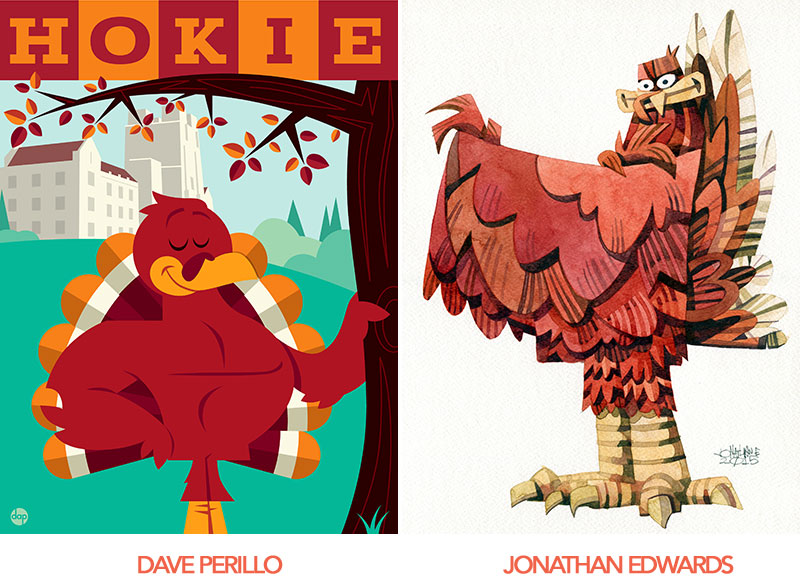
Chad Schennum (biological sciences '01) graduated long before April 16, 2007, but like many Hokies, he was struck by the tragedy and searched for a way to pay tribute to its victims.
Then, in 2008, Schennum, a forensic scientist in Richmond, Virginia, and an art aficionado, commissioned artist Tom Whalen to create a HokieBird print that incorporated the number 32 to represent the victims Schennum was pleased with the result, which led him to commission eight more pieces, in addition to two that his wife had made as Christmas presents. Created by graphic designers, painters, tattoo artists, and a comic book illustrator, the pieces vary stylistically.
"I want it to be a smattering of styles, but focused on the same subject matter," Schennum said. "I let them have carte blanche to do whatever they want with the HokieBird, but I request that they somehow integrate the number 32 into it. It could be a subtle thing, like that first piece with 32 stars in the sky, or something a little more obvious."
Nine of the 11 pieces are displayed in Schennum's home, and he's looking for space to accommodate the other two. The collection is his way of remembering the lives lost, and it also motivates him in his job in forensic science.
"Doing what I do as a forensic scientist, I get to assist law enforcement in what they do," Schennum said. "I always keep that number 32 in the back of my head. When I'm at work, I'm doing this for the 32. That's why I'm here."
Around the Drillfield
Features
- We Remember
- Dear Virginia Tech
- Hokie Nation Stronger Together
